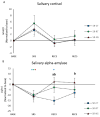Strategies to Limit Cognitive Impairments under Sleep Restriction: Relationship to Stress Biomarkers
- PMID: 35203992
- PMCID: PMC8869873
- DOI: 10.3390/brainsci12020229
Strategies to Limit Cognitive Impairments under Sleep Restriction: Relationship to Stress Biomarkers
Abstract
Adding relaxation techniques during nap or auditory stimulation of EEG slow oscillation (SO) during nighttime sleep may limit cognitive impairments in sleep-deprived subjects, potentially through alleviating stress-releasing effects. We compared daytime sleepiness, cognitive performances, and salivary stress biomarker responses in 11 volunteers (aged 18-36) who underwent 5 days of sleep restriction (SR, 3 h per night, with 30 min of daily nap) under three successive conditions: control (SR-CT), relaxation techniques added to daily nap (SR-RT), and auditory stimulation of sleep slow oscillations (SO) during nighttime sleep (SR-NS). Test evaluation was performed at baseline (BASE), the fifth day of chronic SR (SR5), and the third and fifth days after sleep recovery (REC3, REC5, respectively). At SR5, less degradation was observed for percentage of commission errors in the executive Go-noGo inhibition task in SR-RT condition compared to SR-CT, and for sleepiness score in SR-NS condition compared both to SR-CT and SR-RT. Beneficial effects of SR-RT and SR-NS were additionally observed on these two parameters and on salivary α-amylase (sAA) at REC3 and REC5. Adding relaxation techniques to naps may help performance in inhibition response, and adding nocturnal auditory stimulation of SO sleep may benefit daytime sleepiness during sleep restriction with persistent effects during recovery. The two strategies activated the autonomic nervous system, as shown by the sAA response.
Keywords: auditory EEG slow oscillation; cognition; recovery; relaxation technique; sleep-deprived; stress biomarkers.
Conflict of interest statement
The authors declare no conflict of interest.
Figures







Similar articles
-
Do night naps impact driving performance and daytime recovery sleep?Accid Anal Prev. 2017 Feb;99(Pt B):416-421. doi: 10.1016/j.aap.2015.11.009. Epub 2015 Nov 23. Accid Anal Prev. 2017. PMID: 26616017
-
Using relaxation techniques to improve sleep during naps.Ind Health. 2018 Jun 1;56(3):220-227. doi: 10.2486/indhealth.2017-0092. Epub 2018 Jan 13. Ind Health. 2018. PMID: 29332862 Free PMC article.
-
Decreased arousals among healthy infants after short-term sleep deprivation.Pediatrics. 2004 Aug;114(2):e192-7. doi: 10.1542/peds.114.2.e192. Pediatrics. 2004. PMID: 15286256
-
The nighttime nap strategies for improving night shift work in workplace.Ind Health. 2005 Jan;43(1):24-9. doi: 10.2486/indhealth.43.24. Ind Health. 2005. PMID: 15732300 Review.
-
The effects of napping on cognitive functioning.Prog Brain Res. 2010;185:155-66. doi: 10.1016/B978-0-444-53702-7.00009-9. Prog Brain Res. 2010. PMID: 21075238 Review.
Cited by
-
Interest of the BLAST paradigm and salivary markers for the evaluation of sleepiness in drivers.Front Neurosci. 2022 Sep 7;16:991528. doi: 10.3389/fnins.2022.991528. eCollection 2022. Front Neurosci. 2022. PMID: 36161153 Free PMC article.
-
A continuous approach to explain insomnia and subjective-objective sleep discrepancy.Commun Biol. 2025 Mar 12;8(1):423. doi: 10.1038/s42003-025-07794-6. Commun Biol. 2025. PMID: 40075150 Free PMC article.
-
Focus on Multidisciplinary Aspects of Sleep Medicine.Brain Sci. 2023 Sep 15;13(9):1327. doi: 10.3390/brainsci13091327. Brain Sci. 2023. PMID: 37759928 Free PMC article.
References
-
- Rabat A., Gomez-Merino D., Roca-Paixao L., Bougard C., Van Beers P., Dispersyn G., Guillard M., Bourrilhon C., Drogou C., Arnal P.J., et al. Differential Kinetics in Alteration and Recovery of Cognitive Processes from a Chronic Sleep Restriction in Young Healthy Men. Front. Behav. Neurosci. 2016;10:95. doi: 10.3389/fnbeh.2016.00095. - DOI - PMC - PubMed
LinkOut - more resources
Full Text Sources
Research Materials
Miscellaneous

